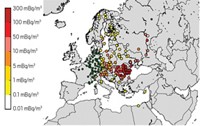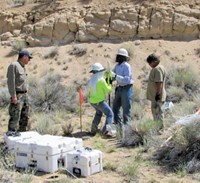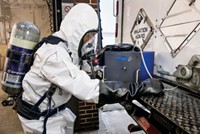Advertisement
Grab your lab coat. Let's get started
Welcome!
Welcome!
Create an account below to get 6 C&EN articles per month, receive newsletters and more - all free.
It seems this is your first time logging in online. Please enter the following information to continue.
As an ACS member you automatically get access to this site. All we need is few more details to create your reading experience.
Not you? Sign in with a different account.
Not you? Sign in with a different account.
ERROR 1
ERROR 1
ERROR 2
ERROR 2
ERROR 2
ERROR 2
ERROR 2
Password and Confirm password must match.
If you have an ACS member number, please enter it here so we can link this account to your membership. (optional)
ERROR 2
ACS values your privacy. By submitting your information, you are gaining access to C&EN and subscribing to our weekly newsletter. We use the information you provide to make your reading experience better, and we will never sell your data to third party members.
Environment
Tracking Terror Underground
An airflow study of the New York City subway could improve responses to airborne chemical, radiological, and biological attacks or accidents
by William G. Schulz
August 19, 2013
| A version of this story appeared in
Volume 91, Issue 33

At a secret operations center in lower Manhattan recently, investigators from the New York City Police Department (NYPD) and the Department of Energy’s Brookhaven National Laboratory (BNL) suddenly began punching numbers on cell phones and speaking over the crackle of walkie-talkies, trying to track down a “black box” apparatus that had mysteriously gone missing. The box was designed to sample a tracer gas as it moved through the New York City subway system. It was a tense moment of drama on the last of three test days this summer for the Subway-Surface Air Flow Exchange Study—also known as S-Safe—the largest urban airflow study ever conducted, according to BNL researchers.
With the help of the police and some 100 local undergraduate science students, BNL researchers released inert perfluorocarbon (PFC) tracer gases in and near the New York City subway to trace the subway system’s airflow dynamics. Understanding how air—and any chemical, biological, or radioactive contaminants it might carry—moves through subway tunnels or the concrete canyons above is serious business. If a terrorist attack or an accident released those contaminants, city officials need to know where and how fast they might move. The information could tell officials where to begin evacuating or which subway stations to shut down to minimize spread of a poison cloud.
The researchers released and collected samples at some 250 locations in Manhattan and surrounding boroughs, both in and above the subway system.
“We want to understand in a comprehensive way” how a contaminant might move through the subway system with the airflow, says study codirector and BNL research engineer Paul D. Kalb. Over the coming months, he says, researchers will analyze the approximately 50,000 data points collected in the study. This information will then feed into further planning for emergency response. “We plan to integrate the data into an easy-to-use decision support software tool to assist emergency management personnel in responding to the release of toxic materials and determining safe zones for evacuation or sheltering and how best to operate transit systems,” he says.
There is precedent for the concerns regarding subway systems. In 1995, for instance, the Aum Shinrikyo religious cult in Japan released deadly sarin gas in the Tokyo subway system, killing eight people and injuring thousands more. It’s the sort of nightmare scenario no one wants to see happen again.

“The NYPD works for the best but plans for the worst when it comes to potentially catastrophic attacks such as ones employing radiological contaminants or weaponized anthrax,” says Police Commissioner Raymond W. Kelly. He adds that “this field study with Brookhaven’s outstanding expertise will help prepare and safeguard the city’s population in the event of an eventual attack.” The NYPD commissioned BNL to conduct S-Safe with a $3.4 million grant from the Department of Homeland Security.
S-Safe used two types of black boxes. The first released the PFC tracer gas through an evaporation process. The other type held an array of 12 glass tubes, each packed with an adsorbent sensitive to PFC gases ranging in concentration from parts per quadrillion to parts per million. The arrays are set up to record movement of a plume of gas at a known flow rate across the array.
Kalb says that some of the tracer gas collection boxes were made by the lab and some were supplied by contractor Battelle Memorial Institute. The BNL samplers had the added benefit that they could be remote controlled, were Wi-Fi capable, and had a GPS tracking device built in.
When sampling with the collection boxes was finished, they were taken back to BNL for analysis. The glass collection tubes were carefully removed and the PFC gases analyzed using gas chromatography. Using the results of the analysis and other data, Kalb and his team will begin trying to piece together, data point by data point, the movement and degradation of the tracer gas plumes.
A full report on the study including its results and conclusions will not be completed until the end of the year and will not be publicly available; officials are concerned such information could serve as a blueprint to terrorists. The police department, for security reasons, has been cautious about revealing many details of the experiment, including the exact analogs of the inert PFC tracer gases used to track airflow in the subway system.
The public was notified about the experiments starting in April, but notices of exact test days were not posted until the night before. The study partners say the precautions were needed to avoid possible disruptions of the experiment by ad hoc provocateurs. Someone had already placed bogus flyers in the streets and in the subway system falsely claiming that BNL and the police were using dangerous chemicals for the study. By not revealing the exact tracer gases used—all of them commercially available—the researchers avoided attempts to ruin the experiment by inundating the area with the same or similar PFC gases.
This summer’s work complements and builds on a 2005 Pacific Northwest National Laboratory study of airflow in Manhattan, including around its storied skyscrapers and other buildings. Again, the researchers used tracer gases and collection boxes, along with meteorological and other data, to understand what could happen if any sort of airborne hazard were to be released.
According to a DOE overview of the 2005 study, the tracer gases used were perfluorodimethylcyclobutane, perfluoromethylcyclopentane, perfluoromethylcyclohexane, perfluoro-1,2-dimethylcyclohexane, perfluoroisopropylcyclohexane, perfluorotrimethylcyclohexane, as well as sulfur hexafluoride. Kalb says harmless PFC tracer gases like these—odorless, colorless, and tasteless—have been used safely as tracer gases in airflow studies for more than 30 years.
Similar, smaller-scale airflow studies have been done in the Washington, D.C., and Chicago subway systems. Cities need to do their own testing because different subway systems have different characteristics, Kalb and other researchers point out.
Police and other emergency services officials from around the world have been concerned about the vulnerability of subway systems to airborne poisons for some time. Argonne National Laboratory research scientist David F. Brown, who has participated in some earlier subway system studies, was on hand for the last day of the S-Safe study. He says the concerns reach back to the 1995 attack in Tokyo, but the concerns—and the will to fund needed research—hit new heights after the terrorist attacks of 9/11. And the concern has continued with the ongoing threat of terrorists attacks from al-Qaeda and other groups.
As the last day of the S-Safe experiment drew to a close, Kalb chuckled, shook his head and said of the missing box, “We planned for just about every contingency but this.” But then his phone rang again and the caller informed him that the missing collection box had been located by city workers. It seems a car had veered off of the road and struck the utility pole to which the box was attached.
But Kalb was not concerned. Even if the sampler was trashed, his team had the data they need to further public safety in the Big Apple.





Join the conversation
Contact the reporter
Submit a Letter to the Editor for publication
Engage with us on Twitter